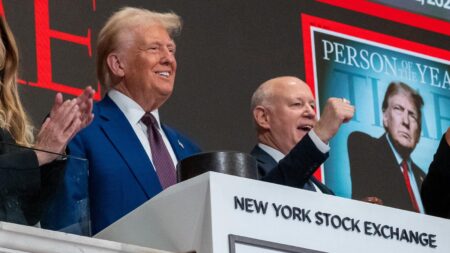Christmas came early for bitcoin this year. On the back of record-breaking launches of ETFs backed by the likes of BlackRock and Fidelity, which have accumulated $112 billion in bitcoin, and president Donald Trump’s reelection in November, the digital asset crossed $100,000. Enthusiasts are expecting 2025 to be more bullish as a pro-crypto congress is coming in power with promises to finally pass regulation that will move the industry out of the proverbial penalty box.
Hype cycles like this create unbridled optimism, and a healthy dose of FOMO, but investors should proceed with caution. And this does not mean which tokens one chooses to speculate in. There are hundreds of crypto exchanges in the world – essentially retail brokerage firms – with fancy websites, attractive features, and yield propositions and promises to keep your money safe.
But all crypto exchanges and marketplaces are not created equal. There are significant differences between the types and number of licenses they hold and how they safeguard your digital assets. Anyone who was burned by the collapse of FTX in 2022 knows how important that can be. Additionally, not every exchange provides the same trading opportunities or charges the same amount. The top firm on Forbes’ third annual Best Crypto Exchange ranking, which analyzed more than 200 firms, is $85 billion Chicago-based CME Group. While this giant futures exchange, founded in 1898 to trade butter and eggs, is not suitable for most retail investors, we gave it high scores because in the wild and wooly world of crypto, safety is paramount and the CME Group is highly regulated by the CFTC. While crypto is still a tiny part of what is traded at CME, during 2024 it traded $1.4 trillion in futures contracts for digital assets such as bitcoin or ether. CME Group offers such things as Micro Bitcoin and Micro Ether futures and options, with minimums of $300 for the smallest of futures contracts, that customers can gain access to via traditional brokerage firms like Charles Schwab and Fidelity.
When it comes to retail oriented exchanges $70 billion (market cap) Coinbase earned the #2 spot in the rankings. Coinbase is the only major publicly-traded cryptocurrency exchange in the U.S. and its customers pay more for this perceived safety in fees and transaction costs. Thanks to some 8 million active accounts, it is the largest custodian of bitcoin in the world, holding 2.4 million worth a staggering $245 billion at current price levels. Asset safety is the most important feature exchange customers demand according to our survey of retail crypto trade.
UK-based Bitstamp, a global exchange with a significant presence in Europe, came in third, with Binance (the world’s largest crypto exchange by trading volume) coming in fourth and Menlo Park-headquartered Robinhood, which is predominantly oriented toward stocks and options, taking fifth place. Robinhood, long criticized for gamifying investing to attract a youthful audience, has become something of a meme headquarters holding $15 billion worth of DOGE coin for clients (Shiba Inu inspired token) and added “dogwifhat” to a list that includes Shiba Inu, PEPE, and BONK. Besides meme coins, Robinhood acquired Luxembourg-based cryptoexchange Bitstamp last July for approximately $200 million, with the firms continuing to operate separately pending the necessary board approvals in the coming months. This acquisition may be the start of a consolidation trend for this highly fragmented industry as the most successful firms attempt to break out from their regional focus.
Binance, absent during last year’s rankings due to legal wranglings, continues to be a dominant firm. It claims to have 245 million registered users and its average daily spot trading volume of around $14 billion represents almost a quarter of the $62 billion. The next biggest exchange, Dubai-based Bybit, only has $8.2 billion. Coinbase has an average daily crypto trading volume of $5.3 billion. Binance’s new management team promises to focus more on compliance, which would be a boon for the crypto compliance sector. The remaining firms in the ranking include some of the most prominent worldwide. In the U.S., leading firms include Kraken, Gemini, Crypto.com, and Fidelity. In South Korea, the two major firms are Upbit and Bithumb, while in Japan, they are Bitbank, bitFlyer, and Coincheck, and in Europe, we recognize Revolut, bitpanda, and Bitvavo.
Together, these firms hold an estimated $1.2 trillion in client assets, and, according to the web analytics firm Similarweb, their websites were frequented by a combined 438 million users in November.
Below, please find the 2025 rankings.
Many investors prioritize low fees when deciding where to trade crypto. Most exchanges post their prices for sellers or purchasers online, respectively known as “maker” and “taker” fees; but they do not tell the whole story. Traders also need to be aware of a term called spread, which is the difference between a quoted buying and selling prices in an orderbook. The size of the spread varies by exchange and trading pair, but a general rule of thumb is that platforms with high volume have lower spreads. And vice versa.
Our research revealed that the weighted cost of execution in the crypto market among ranked firms today, and inclusive of spread, is 80 basis points. To do this analysis we used the cost of trading reported by crypto providers to us or via their website, plus average spread information from CoinGecko. The specific test looked at what it would cost to purchase $25,000 of crypto without any volume discounts or other promotions.
While trading fees can be relatively easily controlled, spread is a function of a provider’s overall liquidity. Among ranked firms, the average spread was 64 basis points (bp), with Upbit, Coincheck, and Bitstamp averaging 241bp, 181bp, and 143bp, respectively, as the costliest firms.[ One hundred basis points is the equivalent of one percentage point.] Coinbase’s 19bp spread was among the lowest and slightly bested Binance’s 21bp. There is a lot of variance among firm, if a trader wants to know the cheapest place to buy or sell crypto, it is important to evanluate both the posted fees and spread together.
The chart above shows both fees and spreads and demonstrates that the biggest exchanges by market share tend to have the lowest trading cost, with the exception of Coinbase. Robinhood, which caters to retail traders, has a zero-fee trading model but the numbers above fail to incorporate the spreads,which in Robinhood’s case are a core part of their business model since they sell order flow.
U.S. exchanges with more than a decade of crypto service such as Coinbase and Kraken continue to enjoy high demand despite higher trading costs. Eventually fee compression from competition from firms like Robinhood could drive fees down.
There are several firms that have both expensive and cheap alternatives for heavy users, and Coinbase and Revolut are perfect examples. Coinbase retail clients averaged fees of 126 basis points. But in an effort to retain low-volume but high fee-paying clients the company created a monthly subscription service called Coinbase One that would eliminate fees. Prices range between $30-$300/month depending on volume. A majority of Revolut clients trade using their traditional app and pay 249bp on average, but the firm launched a web platform called Revolut X in select countries late last year that is priced at 10 basis points per trade and is gaining heavy traction.
By Forbes measurement, there were no less than half a billion crypto users globally at the end of 2024.
We enlisted the help of web analytics firm SimilarWeb, to help us determine where the most crypto traders were. The map below gives an estimation of the geographic dispersion of crypto investors.
The largest concentration of traders is in the Asia-Pacific region, which has 160 million visitors. Europe was next with 134 million. The US and Canada added another 56 million. Latin America and the Caribbean had 40 million traders, and Africa was the lowest at 18 million.
Traffic to crypto providers is highly concentrated, with 12 ranked firms and 3 unranked firms each having 10+ million unique visitors. Firms like Binance, Crypto.com, and Bitget prominently display the number of “users” on their website in the tens or hundreds of millions, without defining the term. These firms, along with many others surveyed for this study, did not provide up to date figures on active accounts. However, monthly SimilarWeb data provides a clearer picture and approximate number of users that is consistent across all exchanges.
This analysis reveals that Binance, for example, had 75 million unique users (17% of the total) compared to Coinbase’s 56 million (13%). Robinhood was fourth at 37 million.
But aside from these major global exchanges, there are some providers that focus on just one or two domiciles. The 49 million traders in South Korea are primarily serviced by two major institutions, Bithumb and Upbit, who received a combined total of 70% of all crypto exchange visitors. Much of the remainder went to larger offshore exchanges like Binance, ByBit, and Bitget. While these exchanges are ranked, none are actually licensed to operate in South Korea. The top three firms servicing Japan’s 16 million visitors are Bitflyer, Coincheck, and Bitbank, while Germany’s 15 million go to Austria-based Bitpanda along with Bitget, and Binance. In India, Binance is the biggest exchange, accounting for essentially all of the of the country’s 6 million monthly visitors. The biggest local exchange operating in the south-Asian country is CoinDCX, which received 1.1 million visitors. Turning to Latin America, Brazil’s 14 million visitors primarily went to Binance, Singapore-based Gate.io (which has a sponsorship deal with soccer star Lionel Messi), and Coinbase. Finally, because Russia continues to be under US sanctions, American exchanges like Coinbase, Robinhood, and Kraken do not have a presence in those countries. Given its 18 million monthly users, Russia remains a major crypto trading hub. The biggest destinations are ByBit (6.7 million), HTX (3.5 million), and Binance (2.4 million).
Ed Note: This article has been updated to clarify certain facts about Fidelity Crypto, including that it considers itself to be a marketplace rather than an exchange.
Read the full article here






